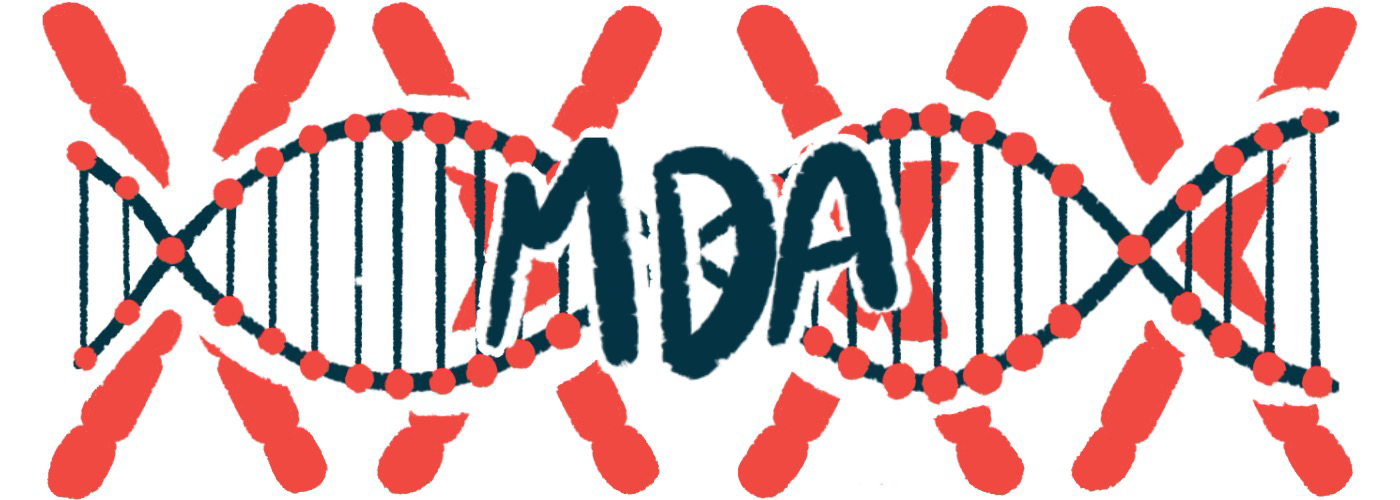MDA 2024: Gene therapy’s benefits most pronounced in young boys
Fordadistrogene movaparvovec is effecting long-term improvements in trial

Among ambulatory boys with Duchenne muscular dystrophy (DMD), a one-time treatment with investigational gene therapy fordadistrogene movaparvovec has helped preserve functions and increase muscle volume for three years, especially in the youngest patients.
That’s according to updated analyses from a Phase 1b trial (NCT03362502), in which the benefits of Pfizer‘s gene therapy candidate were most pronounced in children ages 6-7, with results more variable in those ages 8-12.
Perry Shieh, MD, PhD, of the University of California, Los Angeles, presented the findings at the 2024 Muscular Dystrophy Association (MDA) Clinical & Scientific Conference, held March 3-6 in Orlando, Florida, and virtually.
“The clinically meaningful benefits of fordadistrogene movaparvovec in participants 6-7 years old suggest further exploration is worthwhile in participants with early stage DMD,” Shieh said in the presentation “Fordadistrogene movaparvovec for Duchenne muscular dystrophy: 3-year functional outcomes and changes in thigh and upper-limb muscle volume.”
Duchenne is caused by mutations in the DMD gene, leading to a loss of the dystrophin protein, which is important for muscle health.
Formerly known as PF-06939926, fordadistrogene movaparvovec is a single, into-the-vein infusion of a gene therapy that aims to deliver a gene to bring about production of a shortened but functional dystrophin protein directly to patients’ muscle cells.
The study and its findings
The Pfizer-sponsored Phase 1b trial enrolled 19 boys, ages 4-12, who were ambulatory and on a stable regimen of corticosteroids. Three boys received a low dose of the gene therapy at 100 trillion vector genomes per kg of body weight (vg/kg) and the remaining 16 were given a high dose (200 trillion vg/kg).
The study’s primary one-year analysis demonstrated the therapy’s safety and showed early evidence that it might slow declines in motor function.
In the talk, Shieh discussed three-year safety and efficacy findings from the 16 boys given the high dose of the gene therapy, including six boys ages 6-7 and 10 boys who were ages 8-12.
Motor function was evaluated with the North Star Ambulatory Assessment (NSAA), where higher scores indicate better function.
To put the findings into perspective, they were compared with predictive natural history data generated using the Collaborative Trajectory Analysis Project (cTAP) model, which was built using long-term data from more than 400 untreated DMD patients across several large natural history studies.
Essentially, researchers would plug in the baseline characteristics from trial participants, such as their age, motor function, and walking status, and the model would predict the NSAA trajectory of such patients if left untreated.
Over three years, trial participants saw a 1.4-point slower decline in NSAA scores relative to cTAP, a finding that “favors the gene therapy although it is not statistically significant,” Shieh noted.
Looking at the two age groups separately, younger boys ages 6-7 did experience a “clinically meaningful and statistically significant” preservation of motor function by 3.8 points relative to the cTAP group, according to the scientist.
For children 8 and older, scores were not essentially different from those of the control group.
Overall, 12 of 16 boys experienced a better NSAA trajectory than the expected natural course of disease. These findings included all six of the younger boys and six of the older ones.
Shieh noted that of three older boys who experienced a worse than expected functional trajectory, all were initially predicted to see substantial functional declines and a loss of ambulation if left untreated.
The scientist also pointed out that untreated patients used to build the cTAP model were followed for only about a median of 2.6 years. That means some data is missing at later time points, when older patients start to lose walking function.
Among the older kids, such a limitation “tends to make the control group look better,” Shieh explained.
Thigh muscle volume increased by 4.1% over three years. The younger group of boys exhibited a sustained 17% increase in muscle volume, whereas the older boys did not see significant or sustained improvements.
Both age groups saw sustained improvements in upper limb muscle volume. Younger boys saw 37.4% improvement, while older participants saw 14.9% improvement.
Increases in muscle volume were positively correlated with NSAA functional performance over a follow-up of three years.
Relative to the two-year analysis, Shieh indicated that there were “no new safety signals to report in the past year.”
Trials are ongoing to confirm the gene therapy’s benefits in young patients. That includes the Phase 3 CIFFREO study (NCT04281485), which is testing the gene therapy against a placebo in about 99 ambulatory boys who have Duchenne and are ages 4-7. Findings from that trial are expected to support regulatory applications seeking the gene therapy’s approval.







